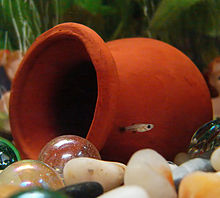Poeciliidae
| Poeciliidae | |
|---|---|

| |
| Sailfin molly (Poecilia latipinna) | |
| Scientific classification | |
| Kingdom: | |
| Phylum: | |
| Class: | |
| Order: | |
| Family: | Poeciliidae Garman, 1895
|
| Genera | |
|
Alfaro | |
Poeciliidae is a family of fresh-water fish which are live-bearing aquarium fish (they give birth to live young). They belong to the order Cyprinodontiformes, tooth-carps, and include well-known aquarium fish like the guppy, molly, platy, and swordtail. The original distribution of the family was eastern United States to northeastern Argentina, and central and southern Africa, including Madagascar. However, due to release of aquarium specimens and the widespread use of species of the genera Poecilia and Gambusia for mosquito control, poeciliids can today be found in all tropical and subtropical areas of the world.
Live-bearing
Although the whole family Poeciliidae is known as "live bearers", there are in the family both true live-bearing "ovoviviparous" species, where the eggs hatch before being laid, so that the female gives birth to live young) and egg-scattering species. All african species are egg-layers, and with the exception of the members of the genus Fluviphylax are all american species livebearers. This distribution suggests that Poeciliidae predate the split between africa and south america 100 million years ago, that live-bearing subsequently evolved in south america, and that north-america was colonized by poeciliids following the formation of the isthmus of Panama 3 million years ago.
Among the live-bearing species there are differences in the mode and degree of support the female gives the developing larvae; although many members of the family Poeciliidae are considered to be lecitrophic (meaning that the mother provisions the oocyte with all the resources it needs prior to fertilization, so that the egg is independent of the mother), but others are matrotrophic (literally means "mother feeding": the mother provides the majority of resources to the developing offspring after fertilization).

Members of the genus Poeciliopsis, for example, show variable reproductive life history adaptations. Poeciliopsis monacha, P. lucida, and P. prolifica form part of the same clade within the genus Poeciliopsis. However, their modes of maternal provisioning vary greatly. P. monacha can be considered to be lecitrophic because it does not really provide any resources for its offspring after fertilization - the pregnant female is basically a swimming egg sac. P. lucida shows an intermediate level of matrotrophy, meaning that to a certain extent the offspring's metabolism can actually affect the mother's metabolism, allowing for increased nutrient exchange. Poeciliopsis prolifica is considered to be highly matrotrophic, and almost all of the nutrients and materials needed for fetal development are supplied to the oocyte after it has been fertilized.
Poeciliopsis elongata, P. turneri, and P. presidionis form another clade which could be considered an outgroup to the P. monacha/P.lucida/P.prolifica clade. These three species are very highly matrotrophic - so much so that in 1947 C. L. Turner described the follicular cells of P. turneri as "pseudo-placenta, pseudo-chorion, and pseudo-allantois".
References
- Froese, Rainer; Pauly, Daniel (eds.). "Family Poeciliidae". FishBase. October 2004 version.
- "Poeciliidae". Integrated Taxonomic Information System. 4 June.
{{cite web}}: Check date values in:|date=and|year=/|date=mismatch (help)
